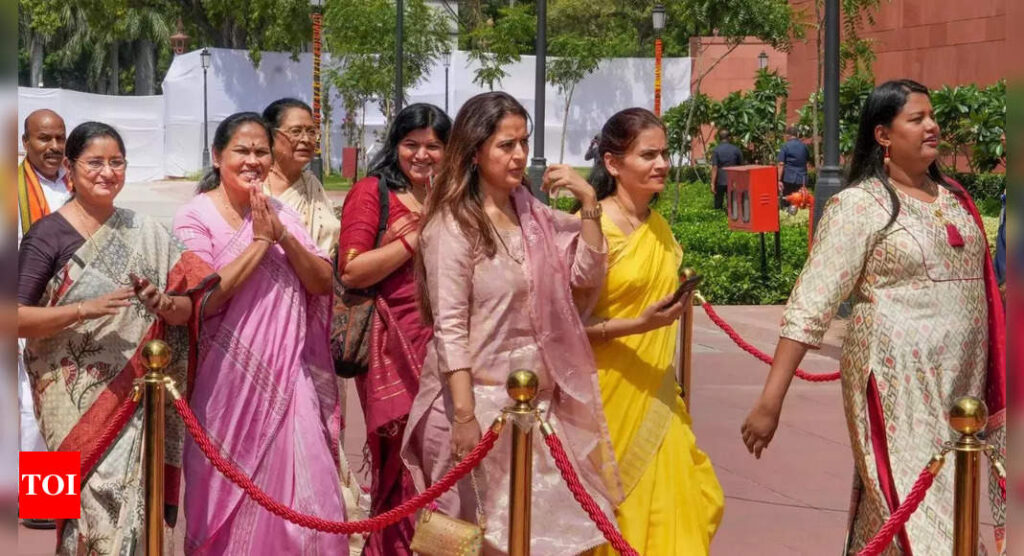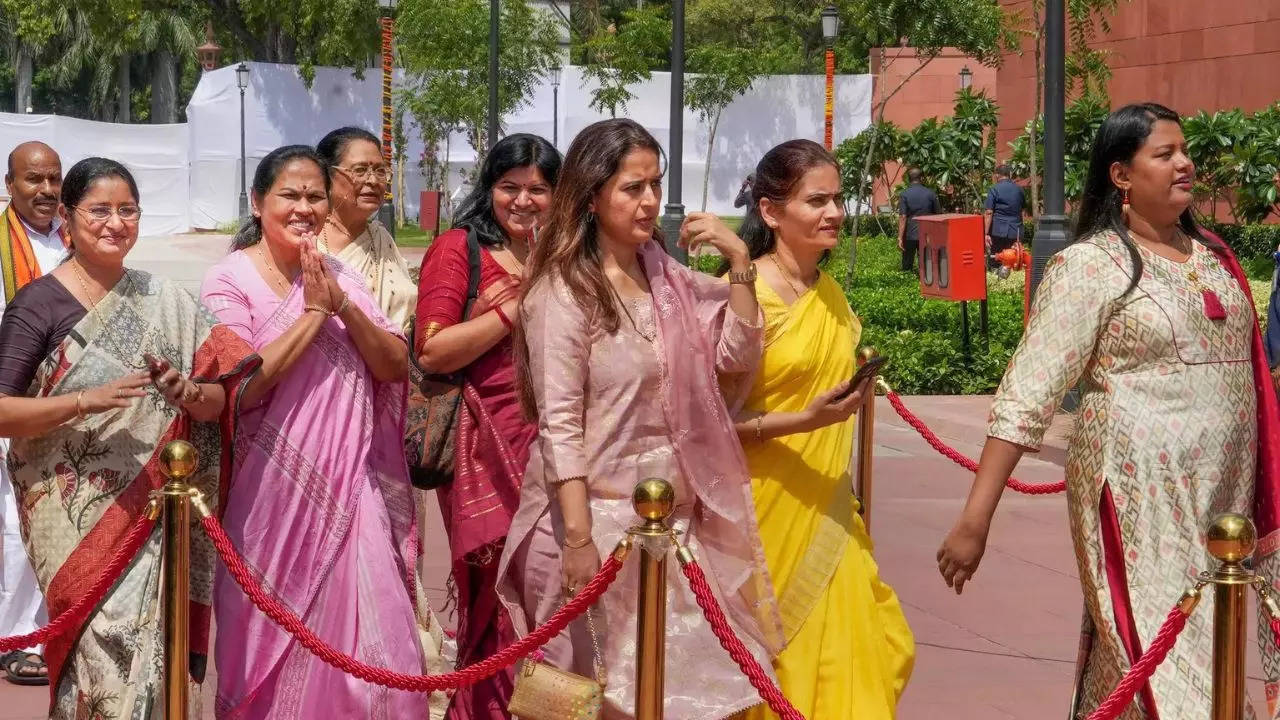[ad_1]
The Constitution (128th Amendment) Bill rules out the implementation of women’s quota in the 2024 general election by unequivocally stating that it shall come into effect only after a delimitation exercise is undertaken based on the first Census after the commencement of the Act.
Census, which is a decennial exercise as per convention, was last due in 2020-2021. However, the Covid pandemic broke out days before ‘houselisting’, the first phase of Census 2021, was to get underway. The Census was deferred and has not resumed even though the last of the Covid restrictions were lifted months ago.
A Census is highly unlikely in the general election year (2024). Besides, the number of Lok Sabha seats and their distribution among the states and UTs was frozen until 2026 by the 91st amendment to the Constitution in 2001. It also laid down that the next delimitation exercise to determine Lok Sabha seats would be based on the first Census to be undertaken after 2026. In the normal course, this would have been the 2031 Census, but with Census 2021 still pending, it may serve as the basis for the next delimitation to be carried out after the freeze lifts in 2026.
Ideally, the delimitation process must be undertaken every 10 years, in line with the Census timeline. A Delimitation Act is enacted each time and a Delimitation Commission set up. Delimitation Commissions have been constituted four times in the past — 1952, 1963, 1973 and 2002 — under the Delimitation Commission Acts of 1952, 1962, 1972 and 2002.
While the number of Lok Sabha seats rose from 489 in 1952 to 543 in 1976, given the focus on population control in the 1970s and the argument that increasing seats based on population would end up “rewarding” the very states that failed to rein in their population, the total seats in Lok Sabha and their stateor UT-wise allocation have remained frozen after 1976. Even the last delimitation order issued in 2008 stuck to 543 seats, although the boundaries of individual seats were redrawn and allocation of SC/ST seats was revised.
However, with India’s population having grown from 55 crore, as per Census 1971, to nearly 140 crore now, experts see a robust case for reviewing Lok Sabha’s strength in proportion to the population to ensure a more equitable representation for the people as well as the states/UTs. If delimitation of seats is done in the postfreeze scenario, the women’s quota in Lok Sabha will be one-third of the enhanced number of seats in the lower House.
Usually, a retired Supreme Court judge heads a Delimitation Commission, with the chief election commissioner and respective state election commissioners as ex-officio members. The delimitation process itself may take several years: nearly six years separated the constitution of the last delimitation panel under Justice Kuldip Singh (retired) and issuance of the delimitation order. This, when its man date was not to change the total and statewise seats in Lok Sabha.
A Delimitation Commission redraws and realigns the seats based on the population figures of the Census it is mandated to follow. The population records and district maps are first sourced from the Office of the Registrar General of India & Census Commissioner and the Surveyor General of India, respectively, followed by consultations with the administrative machinery. A draft delimitation proposal is drawn up based on these inputs and discussed with associate members, who are essentially MPs and MLAs.
A draft proposal is then prepared, incorporating or rejecting the suggestions made by the associate members, and placed in the public domain for suggestions and objections from the public, followed by holding of state-wise public hearings. Finally, based on the public hearings, the final delimitation order is published. This cannot be challenged in any court of law.
Census, which is a decennial exercise as per convention, was last due in 2020-2021. However, the Covid pandemic broke out days before ‘houselisting’, the first phase of Census 2021, was to get underway. The Census was deferred and has not resumed even though the last of the Covid restrictions were lifted months ago.
A Census is highly unlikely in the general election year (2024). Besides, the number of Lok Sabha seats and their distribution among the states and UTs was frozen until 2026 by the 91st amendment to the Constitution in 2001. It also laid down that the next delimitation exercise to determine Lok Sabha seats would be based on the first Census to be undertaken after 2026. In the normal course, this would have been the 2031 Census, but with Census 2021 still pending, it may serve as the basis for the next delimitation to be carried out after the freeze lifts in 2026.
Ideally, the delimitation process must be undertaken every 10 years, in line with the Census timeline. A Delimitation Act is enacted each time and a Delimitation Commission set up. Delimitation Commissions have been constituted four times in the past — 1952, 1963, 1973 and 2002 — under the Delimitation Commission Acts of 1952, 1962, 1972 and 2002.
While the number of Lok Sabha seats rose from 489 in 1952 to 543 in 1976, given the focus on population control in the 1970s and the argument that increasing seats based on population would end up “rewarding” the very states that failed to rein in their population, the total seats in Lok Sabha and their stateor UT-wise allocation have remained frozen after 1976. Even the last delimitation order issued in 2008 stuck to 543 seats, although the boundaries of individual seats were redrawn and allocation of SC/ST seats was revised.
However, with India’s population having grown from 55 crore, as per Census 1971, to nearly 140 crore now, experts see a robust case for reviewing Lok Sabha’s strength in proportion to the population to ensure a more equitable representation for the people as well as the states/UTs. If delimitation of seats is done in the postfreeze scenario, the women’s quota in Lok Sabha will be one-third of the enhanced number of seats in the lower House.
Usually, a retired Supreme Court judge heads a Delimitation Commission, with the chief election commissioner and respective state election commissioners as ex-officio members. The delimitation process itself may take several years: nearly six years separated the constitution of the last delimitation panel under Justice Kuldip Singh (retired) and issuance of the delimitation order. This, when its man date was not to change the total and statewise seats in Lok Sabha.
A Delimitation Commission redraws and realigns the seats based on the population figures of the Census it is mandated to follow. The population records and district maps are first sourced from the Office of the Registrar General of India & Census Commissioner and the Surveyor General of India, respectively, followed by consultations with the administrative machinery. A draft delimitation proposal is drawn up based on these inputs and discussed with associate members, who are essentially MPs and MLAs.
A draft proposal is then prepared, incorporating or rejecting the suggestions made by the associate members, and placed in the public domain for suggestions and objections from the public, followed by holding of state-wise public hearings. Finally, based on the public hearings, the final delimitation order is published. This cannot be challenged in any court of law.
[ad_2]
Source link











More Stories
Congress replaces Kamal Nath, names an OBC as Madhya Pradesh chief | India News
Fire breaks out in ITBP camp in Srinagar; none hurt | India News
Parliament Security: Co-villagers give clean chit to Lalit Jha, parents to move court | India News